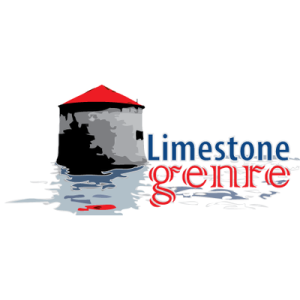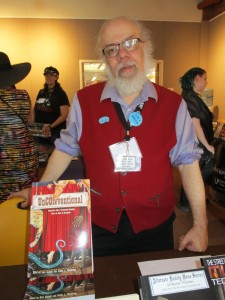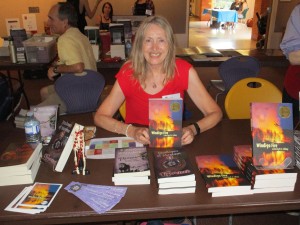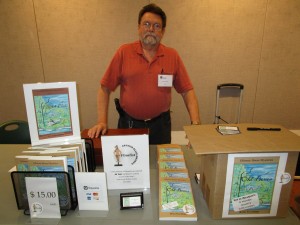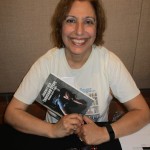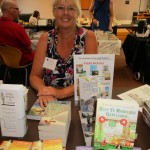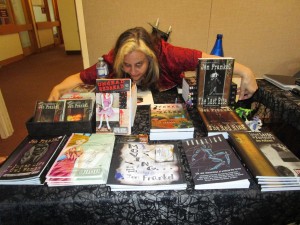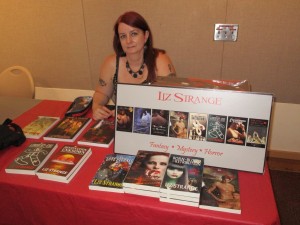Jayne Barnard and I first became friends in cyber space. We met in Real Space at the 2016 Arthur Ellis Banquet where to my delight, she won the Unhanged Arthur for her first crime novel, Where the Flood Falls (Dundern). Her hero, Lacey McCrae, is a former RCMP officer fleeing domestic abuse. Lacey is rebuilding her life in the Calgary foothills but gets drawn into solving homicides.
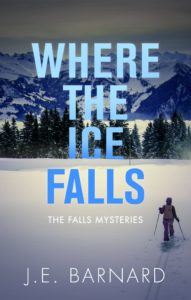 The second book in the series, Where the Ice Falls, debuted on August 10th, giving me an early read of this terrific thriller. The story touches on serious social issues, like cyber fraud while chasing down the true killer through a frigid Alberta winter.
The second book in the series, Where the Ice Falls, debuted on August 10th, giving me an early read of this terrific thriller. The story touches on serious social issues, like cyber fraud while chasing down the true killer through a frigid Alberta winter.
In addition to crime, Jayne writes historical and speculative fiction. She is the creator of the YA steam punk heroine, Maddie Hatter. The first book in the series, Maddie Hatter and the Gilded Gauge, won the Alberta Book of the Year Award. Jayne unleashes her wild imagination in a cozy, vine-covered cottage where she lives with her husband and orange tabby cat.
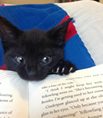 All these great reads are available on Amazon. Where the Ice Falls is also available through Indigo/Chapters, Barnes & Noble, and at Jayne’s long-time home bookstore, Owls Nest Books in southwest Calgary. So readers, EAT THESE BOOKS and welcome, Jayne, to Cyber Café!
All these great reads are available on Amazon. Where the Ice Falls is also available through Indigo/Chapters, Barnes & Noble, and at Jayne’s long-time home bookstore, Owls Nest Books in southwest Calgary. So readers, EAT THESE BOOKS and welcome, Jayne, to Cyber Café!
Jayne, how did you become a writer? Did you know from childhood?
The first time I really threw myself into writing a story was in Grade 3. My teacher let me have a whole week to finish it to my satisfaction. I sold a couple of poems in early adulthood and averaged two sales of short pieces (fiction and non-) per decade until my oldest child hit university.
How do you carve out time write?
I didn’t sell my first novel until after my last child left home. It’s a common trajectory for female writers with families; carving out the time and, more importantly, the mental focus to write, is a challenge.
How did you turn to crime…fiction?
I actually started selling historical short crime stories. “The Medicine Line” and “Tommy Palmer’s Ghost” were finalists for the Great Canadian Story prize from the now-sadly-defunct Canadian Storyteller Magazine. “Each Canadian Son” won the Boney Pete at Bloody Words 2011 in Victoria, BC. I’d written a handful of speculative short stories along the way but none got published until I was already working on my first Steampunk novella, Maddie Hatter and the Deadly Diamond (Tyche Books, 2015).
What was your inspiration for the Falls series and the main character, Lacey McCrae?
At heart the series is about women and the friendships that support us as we grow through the upheavals of early adulthood. Long ago, my best friend from high school joined the RCMP. Back then we were both into running, cycling, swimming, so the fitness requirement wasn’t a big problem for her. By the time she left the Force ten years later, we both had half-finished university degrees and failed marriages. In addition, she had PTSD and I had already been diagnosed with the illness that still rules my life (ME/CFS).
Lacey is loosely based on my friend’s experiences adjusting to civilian life, but her running and other active scenes are rooted in my kinetic memory from those active olden days with my friend. The character of Jan is in many senses my current life; she studied what I studied, and she has ME/CFS which limits what she can do. We both still crave exposure to the arts world we had to leave.
Where the Ice Falls is the second book in the series. How does it continue on from When the Flood Falls?
Where the Ice Falls takes place from early December to early January, six months after the events of Where the Flood Falls. Lacey and Jan were the main players in Flood; Lacey and her roommate Dee are central to Ice.
Dee’s mother is terminally ill, and determined to have a last Christmas with her only child before seeking a medically assisted death. Dee relies on Lacey’s support to come to terms with her mother’s wishes. But Lacey’s already crispy at the edges after months of looking after Dee during her long recovery from last summer’s injuries.
A new character, Zoe, is near breaking point from work, Christmas prep, and her stepsons’ impending visit. When Zoe’s teenage daughter finds a dead intern outside their borrowed ski chalet, all the women are yanked into a chilling holiday season filled with family dysfunctions and psychological stressors that lead inexorably toward danger and death in the cruel wilderness west of Calgary.
Tell us about your Maddie Hatter novella series (Tyche Books).
The Maddie Hatter Adventures are frothy romps that chase Maddie, renegade daughter of Britain’s most respected Steamlord, as she attempts to make her living by investigative reporting. Except no editor will give a young lady an investigative assignment; she’s trapped on the Society pages, writing about women’s fashion.
She has to break out of what we’d now call a ‘pink ghetto’ on her own. Whether hunting for batty Baron Bodmin and his mysterious bloodshot diamond across three seas and two continents, or parasol duelling in Gilded Age New York City with a devious Russian countess, or hunting industrial spies across the calles and alleys of Venice during Carnivale, Maddie needs all her wits – and the help of her clockwork bird, Tweetle-D, to catch the crooks and pen the exposés, or she’ll be relegated to hats-and-hemlines stories forever.
Maddie Hatter is Steampunk-inspired. (I love steam punk BTW) Do tell us more about Steampunk.
Steampunk got its start in the late-Victorian adventure tales of Jules Verne, H.G. Wells, and Arthur Conan Doyle. Yes, the creator of Sherlock Holmes wrote a few Professor Challenger novels too, questing for lost worlds.
The modern twist on this genre is that the gasoline engine was never invented. Steam power kept evolving instead, with new gadgets and advanced transportation and communication technology. Nowadays, Steampunk is not limited to British literary tradition nor to Victorian England. In Australia, Japan, India, Russia, and all across the Western world, Steampunk sub-cultures are flourishing, with festivals bringing together hundreds of costumed revelers ready to show off their gadgets while they participate in parades, teapot races, and, increasingly, parasol duelling.
To be totally honest, my husband and I – both involved in the Alberta Steampunk community for many years – invented parasol duelling for Maddie Hatter’s world and are thrilled that it has been adopted by Steampunks around the globe. The World Championships are held in Alberta each September, but there are duelling groups in England, France, Australia, New Zealand, and several US states.
Both of us contributed stories to the noir anthology, The Dame was Trouble. Your story is cross-genre: a futuristic PI story set in space. Do you see an increasing trend in cross-genre crime fiction?
I think there’s a bright future in SFF/ crime crossovers. Modern readers live in a technologically complex world and expect their fiction to mirror that, but at heart we all want characters we can identify with, whether they’re human, humanoid, android, or entirely alien. Crime writers have been studying the human psyche across the full spectrum of good and evil for a long time; the more we’re able to expand our work to settings beyond the limits of contemporary Earth, the more new readers we’ll find.
What challenges face the cross-genre crime writer?
To write good crossover fiction, you must know the conventions of both genres well before deciding which ones you’ll break, bend, or stand on their heads. While crime fiction is based on human nature and the solution of a puzzle, SFF readers want exotic settings and alternative social structures that challenge them to imagine life outside the confines of the world they know.
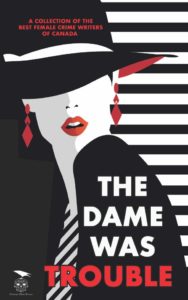 It’s not enough to set a crime story on a space station or alien moon if you don’t think about what new opportunities and limitations the setting imposes on the criminals and the detectives. In “Painted Jade”, my story from The Dame Was Trouble, the body is found floating outside the station, all forensic evidence perfectly preserved by the vacuum of space. However, our intrepid detective must go out there to bring it in, and if you’ve ever felt that leap in your stomach on a carnival ride, imagine how your stomach will feel as it tries to keep your breakfast from rising in the absence of gravity.
It’s not enough to set a crime story on a space station or alien moon if you don’t think about what new opportunities and limitations the setting imposes on the criminals and the detectives. In “Painted Jade”, my story from The Dame Was Trouble, the body is found floating outside the station, all forensic evidence perfectly preserved by the vacuum of space. However, our intrepid detective must go out there to bring it in, and if you’ve ever felt that leap in your stomach on a carnival ride, imagine how your stomach will feel as it tries to keep your breakfast from rising in the absence of gravity.
Ideally you should be reading in the genres you’re writing in, so you can avoid the unrewarding task of crafting, for example, a compelling mystery in a setting that’s been thoroughly explored by a dozen masters of SFF already. You don’t want half your potential readers to dismiss your masterwork as being out-dated, or the other half to toss the book aside because they guessed the murder plot in the first few pages and aren’t interested enough in your careful world-building to keep reading.
What’s next for you, Jayne?
First off, I’ll be editing the third book in The Falls Mysteries. Why the Rock Falls picks up with Lacey and Jan the following summer, when Jan’s old university roommate comes to Bragg Creek with her movie-director husband and promptly attracts old lovers and new dangers in the sun-baked foothills. It will be released in the summer of 2020 by Dundurn Press.
Next, I’ll work on a contemporary Young Adult thriller in which a teenage foster child gets tangled up with a land-developer, a politician, and a deceptively mild-eyed collie with a penchant for escape. I’m quite excited about this blending of my crime-writing background with my YA adventure style. You could say it’s another kind of crossover.
Great having you on Cyber Cafe, Jayne. Really looking forward to reading your new books.
Thanks for inviting me to visit your blog. Always a pleasure to chat with you.

